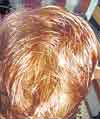IT’S
ONLY SKIN DEEP
By Kumudini Hettiarachchi
The young woman walks in clutching a bundle of cloth to her bosom.
Gently unwrapping it, she says: "Den konde thamba pata tikkak
adui." (The copper colour is less now.)
 |
| Oculocutaneous albinism type 2 |
The beautiful infant, a boy, is very fair with
curly hair the colour of burnished copper. As the doctors sit her
in a corner of the Lady Ridgeway Hospital's Skin Clinic and take
down the case history, one can only imagine the barbs and unkind
remarks that the young woman would face not only from her own family
and in-laws but also from neighbours and friends.
After such a birth, the husband may very well have suspicions about
the paternity of the baby, unaware that it is a skin problem that
makes the baby, unusually fair.
This is albinism, which in recent times has been in the news with
Albinism Associations protesting against the stereotyping of people
with this condition in the form of the violent Silas who goes on
a killing spree in the best-selling book, The Da Vinci Code, released
this week as a controversial movie.
 |
| Rufous Albinism |
"Albinism results from an inherited defect
in melanin synthesis," says Consultant Dermatologist Dr. Jayamini
Seneviratne, explaining that melanin is a chemical in our bodies
that colours our skin, eyes and hair. Made by melanocytes, melanin
is also the principal pigment in the human skin that protects us
from ultra-violet light. "Melanin absorbs and disperses UV
light which would otherwise harm our bodies."
Melanocytes are pigment-containing cells found in the bottom layer
of the epidermis. The melanin synthesized there is transferred to
36 adjacent epidermal cells constituting the epidermal melanin unit.
The melanin is synthesized in structures called melanosomes and
it is the number of melanosomes in melanocytes that determines the
skin colour and not the number of melanocytes in the skin, he says.
"The main enzyme involved in melanin synthesis is tyrosinase,
the function of which is determined by two genes. If both genes
are defective, then the condition called albinism results. There
are around 90 different types of albinism," Dr. Seneviratne
explains, adding, "Tyrosinase related proteins play a lesser
important role in melanin synthesis. Deficiency of this leads to
Brown Albinism."
 |
| Red hair |
Meanwhile, the melanin synthesized is stored and
transferred to other tissues. Defects in these steps could also
lead to albinism-related conditions characterized by light skin,
silver hair, eye problems and a number of other problems, according
him. (Eg: Hermnasky Pudlak Syndrome, Chediak-Higashi Syndrome and
Griscelli Syndrome, described in box)
According to Dr. Seneviratne albinism is a condition that cannot
be cured or treated but certain measures can be taken to improve
the quality of life of those affected.
"Corrective eye-wear, surgical correction of ocular abnormalities
and use of sunscreen are the answers while bone marrow transplantation
can be carried out in Chediak-Higashi Syndrome and Griscelli Syndrome,"
he adds. |


